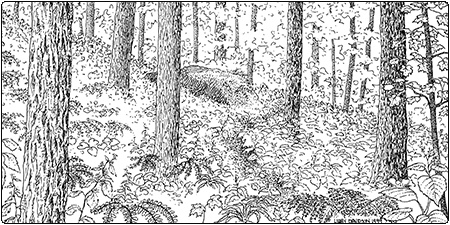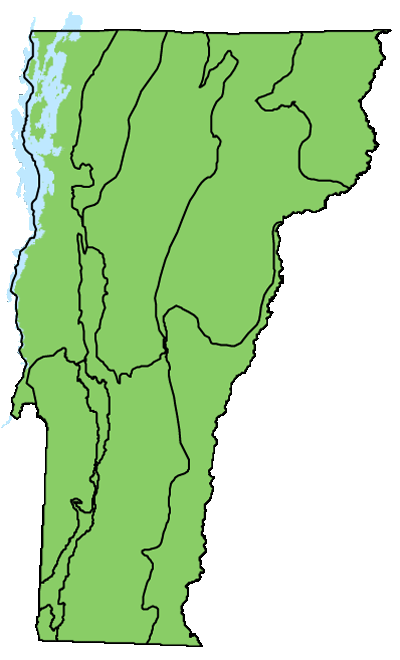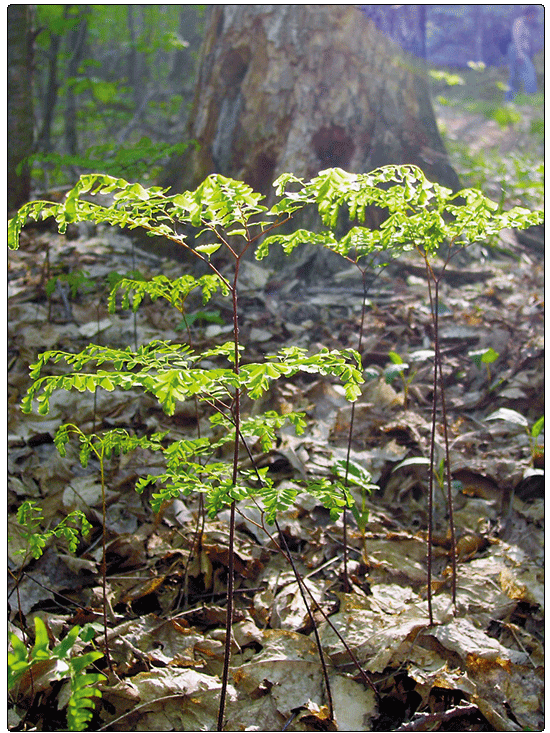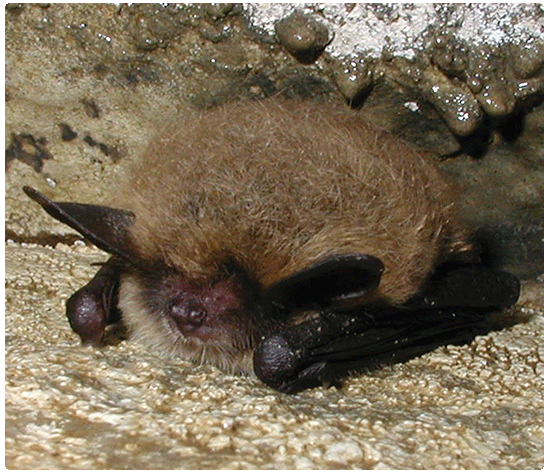Ecology and Physical Setting
Rich Northern Hardwood Forests are quintessentially Vermont. Sugar maple is abundant, making these forests vital to three of Vermont’s economic staples: maple sugar production, forestry, and tourism. Rich Northern Hardwood Forests are places where colluvial processes (downslope movement) or mineral-rich bedrock, or some combination of the two, provide plants with a steady supply of nutrients.
Colluvial processes prevail on lower slopes and benches and also in coves and gullies. Here organic matter and plant nutrients accumulate over time, forming a compost-like soil. If the bedrock or till on such a slope is enriched with calcium and other key plant nutrients, these nutrients will be washed from upper to lower slopes, giving the plants below the greatest advantage. Productivity is high on the lower slopes, as is the overall diversity of plant species. The upper slopes or the convex knobs on such a hill, where nutrients are leached from the soils, will have communities—such as Northern Hardwood Forest, Hemlock Forest, Red Oak-Northern Hardwood Forest, or Dry Oak-Hickory-Hophornbeam Forest—with lower species diversity and lower productivity.
Rich Northern Hardwood Forests can also be found on rolling terrain where calcium-rich bedrock is found close to the surface. Although soils on these sites can be shallow and droughty, the bedrock nevertheless provides ample plant nutrients. Pockets of rich soil are commonly mixed with the small outcrops of calcareous rock. These sites can be quite productive and diverse, with many plants that indicate mineral enrichment.
Overall, the soils in Rich Northern Hardwood Forests range from well drained to somewhat poorly drained. Sometimes there is a dense hardpan at about 18-24 inches from the surface. This restricting layer can be a factor in keeping moisture and nutrients near the surface, where they are readily available to plants. Where soils are moist, productivity is higher, trees produce higher quality wood, and herbaceous plants are more abundant.
Vegetation
Rich Northern Hardwood Forests are high productivity forests: trees grow quickly, and they grow tall and straight. Sugar maple is dominant in the canopy, but basswood and white ash are common as well, and butternuts are scattered. The shrub layer varies from being almost absent in dense shade to well developed in sunny openings. Herbs are often abundant on the forest floor, forming a continuous carpet of lush vegetation in midsummer. Where moisture is plentiful, ferns such as ostrich fern, narrow leaf glade fern, and silvery glade fern form dense fern glades. Most of the herbs are long-lived perennials. Many of them are spring ephemerals that flower and fruit early in spring before trees leaf out, when sunlight is plentiful. By mid-summer some of these plants, like Dutchman’s breeches, have lost all their foliage and are completely invisible above ground. Other plants, like wood nettle and maidenhair fern, persist throughout the summer, displaying large canopies of leaves to gather the filtered light on the forest floor.
The overall diversity of species is high in Rich Northern Hardwood Forests, as is the sheer abundance of biomass on the forest floor. A study of forests in Vermont and New York showed that in plots of uniform size (0.1 hectare, or about 1/4 acre), a representative Rich Northern Hardwood Forest in the Green Mountains had an average of 48 herb species, while other hardwood forest types in the Adirondacks had an average of 27 species. Other studies show similar results.
Wildlife Habitat
Rich Northern Hardwood Forests provide very similar wildlife habitat as Northern Hardwood Forests and support many of the same species. Eastern red-backed salamanders thrive in the rich, moist soils. Spotted salamanders, wood frogs, and other vernal pool species may be present if there is a pool nearby. Breeding birds include hermit thrush, rose-breasted grosbeak, ovenbird, and scarlet tanager. The West Virginia white is a rare butterfly that feeds primarily on the nectar of toothwort, a plant of rich woods. This butterfly remains in the same forest patch that contains its host plant for its entire life. The species is now threatened by forest fragmentation and the spread of non-native invasive plants.
Successional Trends
Rich Northern Hardwood Forests that have been undisturbed for long periods of time will likely be dominated by sugar maple, white ash, and basswood. Forests where natural or human disturbances have created openings may be dominated by a combination of sugar maple, bigtooth aspen, white ash, striped maple, black cherry, white pine, yellow birch, and pin cherry. Which of these species dominate, and for how long, will depend on climate, history, seed sources, and site conditions.
Variants
- Dry Rich Northern Hardwood Forest: This is a Rich Northern Hardwood Forest on well-drained, shallow-to-bedrock soils, primarily associated with the Waits River formation in the Northern Vermont Piedmont. Hophornbeam and white ash are typically common in the canopy. This variant is very similar to Dry Oak-Maple Limestone Forest.
Related Communities
- Northern Hardwood Forest is the community most closely related to Rich Northern Hardwood Forest. The two differ in the availability of plant nutrients in the soils and in species diversity. Often these communities interfinger, with Rich Northern Hardwood Forest occurring in rich coves or benches, surrounded by Northern Hardwood Forest.
- Mesic Maple-Ash-Hickory-Oak Forest can be in similar settings as Rich Northern Hardwood Forest, but differs in having southern species such as hickories and oaks.
- Dry Oak-Maple Limestone Forest is found in areas of shallow soils over limestone or dolostone in the Champlain Valley and other warm-climate areas, and has much in common with Rich Northern Hardwood Forest, but species composition reflects a warmer climate and southern affinities.
- Northern Hardwood Seepage Forest can be highly enriched from groundwater, and can share many species with Rich Northern Hardwood Forest. It is distinguished by the presence of groundwater seepage and a predominance of wetland conditions.
Conservation Status and Management Considerations
Rich Northern Hardwood Forests are common in Vermont, though most examples are small. Exceptionally large examples occur in the eastern Taconic Mountains and are partially protected. Several examples elsewhere are protected as natural areas, and a number of sites are under timber management that considers the long-term ecological integrity of the natural community.
The observations of foresters and ecologists indicate that this community type can recover well from selective harvest, if patch cuts are kept small and precautions are taken against the encroachment of invasive non-native plants, which thrive in the rich soils. Industrial-scale maple sugaring is a new and increasing use that can have long-term effects on these forests. Maintaining a diverse mix of tree species in addition to sugar maple is an important management strategy in any sugarbush. Clearing for agriculture probably has a long-term impact on these forests; the native flora may take a long time to return after a Rich Northern Hardwood Forest site is used for agriculture. In general, activities that alter the downslope movement of soil and nutrients, such as the building of roads across slopes, threaten the integrity of this community.
Rich Northern Hardwood Forests are being changed by the introduction of non-native insects and pathogens. Emerald ash borer will likely kill most of the large white ash in this community, and butternut canker has all but eliminated the butternuts. Finding a living butternut in this community—something that used to be a common occurrence—is today a rare treat.
Distribution/Abundance
Rich Northern Hardwood Forests occur throughout Vermont at low to moderate elevations, from approximately 300 to 2,500 feet. They are most common where the bedrock is calcareous but are also present in areas of nutrient-enriched till or topographically induced enrichment. This community occurs throughout the northeastern United States and adjacent Canada but is less common in neighboring states. Vermont may have the largest examples of this natural community type in the northeast.
Characteristic Plants
Trees
Abundant Species
Sugar maple – Acer saccharum
White ash – Fraxinus americana
Occasional to Locally Abundant Species
Basswood – Tilia americana
Black birch – Betula lenta
Bitternut hickory – Carya cordiformis
Yellow birch – Betula alleghaniensis
American beech – Fagus grandifolia
Black cherry – Prunus serotina
Butternut – Juglans cinerea
Hophornbeam – Ostrya virginiana
Shrubs
Abundant Species
Striped maple – Acer pensylvanicum
Alternate-leaved dogwood – Cornus alternifolia
Occasional to Locally Abundant Species
Maple-leaved viburnum – Viburnum acerifolium
Red-berried elder – Sambucus racemosa
Round-leaved dogwood – Cornus rugosa
Leatherwood – Dirca palustris
Herbs

Abundant Species
Wood nettle – Laportea canadensis
Maidenhair fern – Adiantum pedatum
Blue cohosh – Caulophyllum thalictroides
Wild leeks – Allium tricoccum
Dutchman’s breeches – Dicentra cucullaria
Sharp-lobed hepatica – Anemone acutiloba
Canada violet – Viola canadensis
Pale touch-me-not – Impatiens pallida
Wild ginger – Asarum canadense
Bulblet fern – Cystopteris bulbifera
Christmas fern – Polystichum acrostichoides
White snakeroot – Ageratina altissima
Occasional to Locally Abundant Species
Squirrel corn – Dicentra canadensis
Common toothwort – Cardamine diphylla
Early yellow violet – Viola rotundifolia
Silvery glade fern – Deparia acrostichoides
White baneberry – Actaea pachypoda
Plantain-leaved sedge – Carex plantaginea
Zigzag goldenrod – Solidago flexicaulis
Black snakeroot – Sanicula marilandica
Rattlesnake fern – Botrychium virginianum
Virginia waterleaf – Hydrophyllum virginianum
Herb Robert – Geranium robertianum
Goldie’s wood fern – Dryopteris goldiana
Sprengel’s sedge – Carex sprengelii
Wood millet – Milium effusum
Invasive Non-native Plants
Morrow’s honeysuckle – Lonicera morrowii
Tatarian honeysuckle – Lonicera tatarica
Japanese barberry – Berberis thunbergii
Common buckthorn – Rhamnus cathartica
Wall-lettuce – Mycelis muralis
Rare and Uncommon Plants
American ginseng – Panax quinquefolius
Narrow leaf glade fern – Homalosorus pycnocarpos
Hitchcock’s sedge – Carex hitchcockiana
Summer sedge – Carex aestivalis
Hooker’s orchis – Platanthera hookeri
Goldenseal – Hydrastis canadensis
Broad beech fern – Phegopteris hexagonoptera
Male fern – Dryopteris filix-mas
Puttyroot – Aplectrum hyemale
Small roundleaf orchis – Platanthera orbiculata
Drooping bluegrass – Poa saltuensis ssp. saltuensis
Associated Animals

Eastern red-backed salamander – Plethodon cinereus
Eastern Newt – Notophthalmus viridescens
Eastern chipmunk – Tamias striatus
Hermit thrush – Catharus guttatus
Rose-breasted grosbeak – Pheucticus ludovicianus
Ovenbird – Seiurus aurocapilla
Red-eyed vireo – Vireo olivaceus
Black-and-white warbler – Mniotilta varia
Black-throated blue warbler – Setophaga caerulescens
Scarlet tanager – Piranga olivacea
Hairy woodpecker – Picoides villosus
Rare and Uncommon Animals
West Virginia white – Pieris virginiensis
Northern long-eared bat – Myotis septentrionalis
Places to Visit
Mount Equinox, Manchester, Equinox Preservation Trust, The Nature Conservancy and Vermont Land Trust
Gifford Woods, Killington, Vermont Department of Forests, Parks, and Recreation (VDFPR)
Willoughby State Forest, Westmore and Sutton, VDFPR
